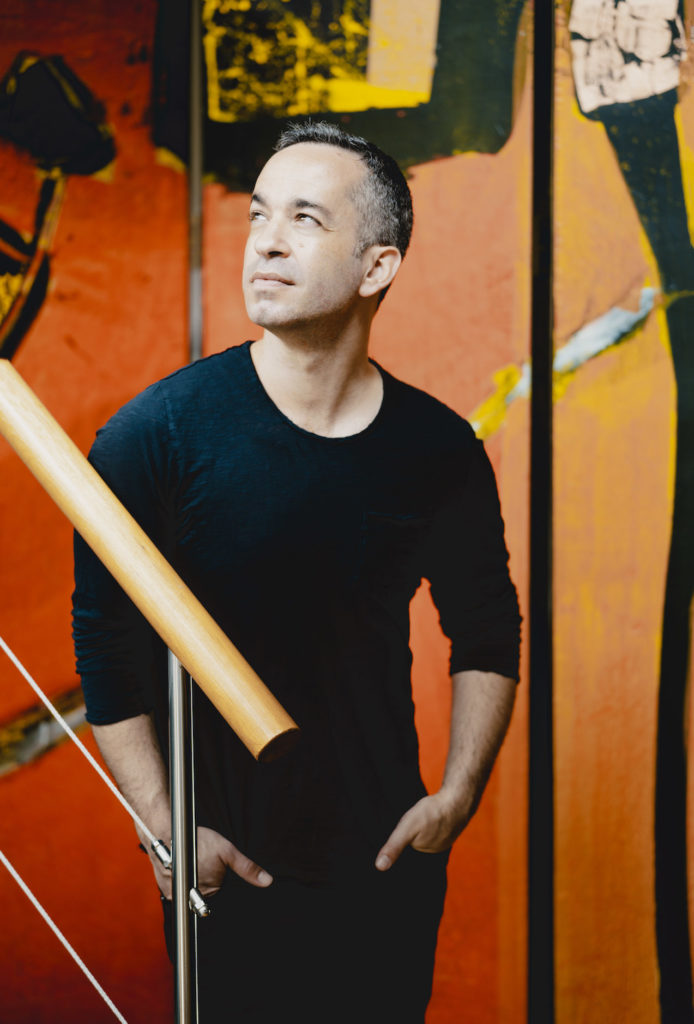Inon Barnatan’s Brahms’ Second Piano Concerto with the San Diego Symphony Amazes Rady Shell Audience
Pianist Inon Barnatan’s previous performances with the San Diego Symphony have been indeed noteworthy, although he has chosen concertos of decidedly modest profile. In January of 2017 he played concertos by Aaron Copland and Andrew Norman, and in 2021 he played Ravel’s G Major Concerto. These concertos call for the finesse and the sophisticated thematic sculpting that make Barnatan’s chamber music collaborations so satisfying, experiences too numerous even to begin to recount over the five years he has served as Music Director of La Jolla’s annual SummerFest.
In a thrilling performance of the Brahms Piano Concerto No. 2 in B-flat Major on Saturday with the San Diego Symphony under Music Director Rafael Payare, however, we experienced the other Barnatan. His brilliant attacks, muscular figurations, and sweeping dramatic gestures released the passion of this wonderfully larger than life concerto. For Barnatan, this was a commanding ebullience we had not experienced before, and in Rafael Payare, he found an ideal collaborator who both demanded and focused the orchestra’s powerful potential throughout this resplendent score.Barnatan and Payare stressed the grandeur of the opening movement, eloquently expressed by Barnatan’s colorful, alluring themes and the resonant calls from Principal Horn Benjamin Jaber. Payare savored the contrast of the second movement Scherzo’s impassioned surges while Barnatan charmed with rhapsodic forays.
Principal Cello Yao Zhao’s voluptuous solo provided a breathtaking opening to the Andante, which Barnatan matched with the comforting excursions that suggested the buoyant air of a Brahms solo piano Intermezzo. After ample elegant dialogue between orchestra and soloist, Principal Clarinet Sheryl Renk and second chair Max Opferkuch offered their sensuous account of Brahms’ lush clarinet duet that brings the cello back for a reprise of his delectable opening theme. Payare led an exuberant Finale propelled by Barnatan’s scintillating evocation of those ever present Romani dancers whose joie de vivre the composer found so endearing.
Iranian composer Gity Razaz’s Methuselah (In Chains of Time), a short orchestral ode to a 5,000-year-old tree pine tree in California’s remote Inyo County, projected endurance in upper-case letters. Opening with an enormous percussive rumbling from the bowels of the orchestra, a flurry of muted trumpet fanfares and whirring woodwind motifs merge to create a mighty sonic whirlwind. The full orchestra soon weighs in with urgent layers of anxious motifs moving slowly under the bass drum’s insistent beat. When the whirring woodwind arpeggios returned, Concertmaster Jeff Thayer added a silvery, high-pitched but haunting solo that perhaps symbolized the sacred mystery of the tree’s endurance.
For the record, I should note that Razaz’s Methuselah was the third musical world premiere I covered in less than a week here in San Diego: on Tuesday Art of Elan premiered Rand Steiger’s Grace and Friday Sacra/Profana premiered Amy Gordon’s Songs of Hope in Strange Times!
Payare continued the orchestra’s effulgent Brahmsian sonority with Antonin Dvořák’s Symphony No. 7 in D Minor. After yet another turbulent beginning, Payare allowed the opening movement of the Dvořák Seventh to relax into a stream of mellifluous themes that gradually developed their heroic conclusion. The composer’s Poco Adagio features a dulcet woodwind choir intoning gossamer themes over subtle pizzicato low strings that gradually expand to encompass the full orchestra, a movement gracefully shaped by Payare. After a dashing Scherzo propelled by bracing, unexpected cross rhythms, Payare drew a triumphant Finale from the full orchestra that crowned the Seventh Symphony with well earned grandeur.
This concert was presented by the San Diego Symphony in their bay-front home, The Rady Shell at Jacobs Park, on Saturday, May 20, 2023.

Ken Herman, a classically trained pianist and organist, has covered music for the San Diego Union, the Los Angeles Times’ San Diego Edition, and for sandiego.com. He has won numerous awards, including first place for Live Performance and Opera Reviews in the 2017, the 2018, and the 2019 Excellence in Journalism Awards competition held by the San Diego Press Club. A Chicago native, he came to San Diego to pursue a graduate degree and stayed.Read more…

